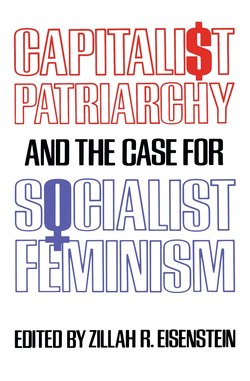Читать книгу Capitalist Patriarchy and the Case for Socialist Feminism - Zillah R. Eisenstein - Страница 12
На сайте Литреса книга снята с продажи.
ОглавлениеMOTHERHOOD, REPRODUCTION, AND MALE SUPREMACY
As we have mentioned, when Engels noted the dual importance for society of production and reproduction he uncovered a key political reality which neither he nor most political analysts since have understood. Most existing discussions of reproduction do not recognize it as a politically necessary aspect of any society that must be organized and ordered along with the other relations of survival. As a result there is no recognition of the political base intrinsic to the biological capacity for reproduction and the societal necessity for it. It has been the particular concern of socialist feminists, including Juliet Mitchell, Sheila Rowbotham, Gayle Rubin, Nancy Chodorow, and Linda Gordon, to remedy this situation.
Nancy Chodorow focuses on mothering as part of the operation of male dominance. Given that both the idea and the reality of motherhood define the activities of most women, Chodorow seeks to explain how motherhood as an institution is reproduced through mothering. Motherhood focuses not only upon the reproduction of children, but also on the reproduction of society: mothering reproduces not only new children but new mothers. This society reproduces the relations of male supremacy and the hierarchical relations necessary to the capitalist marketplace.
In Woman’s Body, Woman’s Right, Linda Gordon showed that a woman’s lack of control of reproduction is part of the social relations that define her oppression, and that the struggle for such control has been part of the varied struggle for women’s rights and liberation. These relations and struggles must be understood as part of the history of patriarchal, male-supremacist, and/or sex-gender systems. Here Gordon shows that the struggle for control over reproductive capacities is central though not sufficient for the struggle for liberation. She describes the struggle in three stages: (1) nineteenth-century feminism; (2) early twentieth-century feminist socialism; and (3) 1970s feminism. At each stage women have moved toward a fuller understanding of how men control them through control of reproduction. Gordon’s basic thesis is that “birth control does not mean population control or birthrate reduction or planned families but reproductive freedom.” Reproductive freedom is defined as the control over one’s reproductive capacities, not the elimination of biological reproduction. Reproductive self-determination becomes a basic condition for sexual equality and political revolution.
Socialist theory has dealt insufficiently with the reality of women as mothers and radical feminism only begins to probe the question in its full political, economic, and psychoanalytic sense. It has been socialist feminist women who have begun to push the analysis of psychoanalysis to better understand the dynamic involved in the social relations of mothering as it is practiced. Juliet Mitchell was important in opening up this area for analysis, although I think she reinvents the problem of woman’s oppression as belonging to the unconscious realm disconnected from real conditions. Nancy Chodorow begins to tackle the question of how the unconscious operates out of a series of conscious realities. If the unconscious were not reinforced daily by the conscious political organization of the society, the unconscious would lose its capacity for reproduction. An analysis of the dynamics of the mind must be integrated with the society which produces, defines, redefines, and reproduces the mind. Socialist feminists have only begun this difficult task; the beginnings are presented in this section.
Related Reading
Bachofen, J. J., Myth, Religion, and Mother Right: Selected Writings (Princeton: Princeton University Press, 1967).
Bamburger, Joan, “The Myth of Matriarchy,” and Chodorow, Nancy, “Family Structure and Feminine Personality,” in Woman, Culture and Society, ed. Michelle Rosaldo and Louise Lamphere (Stanford: Stanford University Press, 1974).
Briffault, Robert, The Mothers: The Matriarchal Theory of Social Origins (New York: Macmillan, 1931).
Chodorow, Nancy, “Oedipal Asymmetries and Heterosexual Knots,” Social Problems (April 1976).
Dinnerstein, Dorothy, The Mermaid and The Minotaur: Sexual Arrangements and Human Malaise (New York: Harper & Row, 1976).
Engels, Friedrich, The Origin of the Family, Private Property and the State (New York: International Publishers, 1972).
Erikson, Erik H., “Womanhood and the Inner Space,” Identity, Youth, and Crisis (New York: Norton, 1968).
Freud, Sigmund, “The Passing of the Oedipus Complex. Some Psychological Consequences of the Anatomical Distinction Between the Sexes (1925),” “Female Sexuality (1931),” Sexuality and the Psychology of Love, ed. Philip Rieff (New York: Collier Books, 1963).
Mitchell, Juliet, Psychoanalysis and Feminism (New York: Pantheon, 1975).
Neumann, Erich, The Great Mother: An Analysis of the Archetype (1963; Princeton: Princeton University Press, 1972); The Origins and History of Consciousness (1954; Princeton: Princeton University Press, 1970).
Pomeroy, Sarah B., Goddesses, Whores, Wives and Slaves (New York: Schocken Books, 1975).
Rubin, Gayle, “The Traffic in Women,” in Toward an Anthropology of Women, ed. Rayna Reiter (New York: Monthly Review Press, 1975).
Shorter, Edward, The Making of the Modern Family (New York: Basic Books, 1975).
